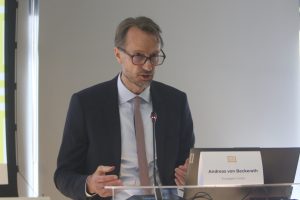To mark the publication of the book entitled “Media pluralism in the digital era: Legal, Economic, Social, and Political Lessons Learnt from Europe”, the European Federation of Journalists (EFJ) interviewed Iva Nenadic, Research Fellow at the Centre for Media Pluralism and Media Freedom (CMPF) at the European University Institute. Co-edited with Elda Brogi and Pier Luigi Parcu, this book draws from over a decade of research through the Media Pluralism Monitor (MPM) and provides essential insights into the evolving media landscape across Europe.
Could you tell us about your role at the Centre for Media Pluralism and Media Freedom (CMPF) and the mission of this centre?
Iva Nenadic: The Centre for Media Pluralism and Media Freedom (CMPF) at the European University Institute in Florence is a research and training centre that conducts interdisciplinary research on media freedom and pluralism in Europe and beyond, to provide knowledge support to the international, European, and national policy and rulemaking processes. Some of our research lines include: the exploration of news deserts in Europe, the role of online platforms and artificial intelligence in shaping the information environment and challenging information integrity, economic sustainability of journalism, and its relationship with young audiences. Ever since joining the CMPF in 2016, I have been involved in coordinating and developing the methodology of the Media Pluralism Monitor (MPM) and its implementation across the EU member states and candidate countries. Further to being a research fellow at the CMPF, I am also an assistant professor of media and digital policy at the University of Zagreb (Faculty of Political Science).
How did you manage the collaboration with contributors from 27 European countries, and what challenges did you face in keeping the content cohesive?
Iva Nenadic: The book, which I had the privilege of co-editing with Elda Brogi, CMPF’s Scientific Coordinator, and Pier Luigi Parcu, CMPF’s Director, is a project that truly embodies the spirit of collaboration that the MPM project aimed to achieve from its very beginning. It was born from over a decade of dedicated research through the Media Pluralism Monitor. The years we spent working together with the MPM network made it possible to bring together 36 scholars, journalists, and researchers from 27 European countries. This long-standing collaboration had already established a strong foundation of trust and seamless communication, which was crucial for managing such a diverse team. Each contributor brought their unique perspective, grounded in the realities of their respective national media landscape. That diversity is also what makes the book so valuable. It offers a comparative analysis of the evolving conditions and standards essential for sustainable, free, and pluralistic media and journalism in Europe. The book doesn’t just synthesise legal, economic, and political lessons learnt over the past ten years — it also serves as a foundation for informed and lasting policies to support media pluralism in the face of contemporary information challenges.
You drew on data from the Media Pluralism Monitor (MPM) project for this book. Could you share some key insights or trends that have emerged from the latest monitoring report across EU member states and candidate countries?
Iva Nenadic: Indeed, the book draws on data from the Media Pluralism Monitor project, a scientific tool designed and implemented on a regular basis to document the risks to media pluralism and to provide insights into central dimensions of media systems across the EU and candidate countries. The 13 chapters include detailed explorations, country cases, and good practice examples on:
- the platformisation of the information environment, disinformation, media literacy, and broader technology challenges;
- safety of journalists;
- market plurality, transparency of ownership, media concentration, media viability, and digital platforms’ dominance;
- political independence of the media, conflicts of interests in the media sector, editorial autonomy, independence of public service media and of the media authorities;
- social inclusiveness, especially through inclusive management and representation of women and community media.
Throughout the years, the MPM has indicated a number of structural risks to media freedom and pluralism, starting from the protection of fundamental rights and conditions for journalists to conduct their job safely. Some of the key insights from the MPM2024, include the continuous deterioration of working conditions for journalists, which stands as a serious obstacle to attracting young talent to journalism. Furthermore, concerns about the safety of journalists in the EU have persisted since the assassination of Maltese investigative journalist Daphne Caruana Galizia in 2017, whose murder remains an unresolved case of impunity even after seven years, as well as the murder of Slovak journalist Ján Kuciak in 2018. In the MPM2024, digital safety of journalists is scoring a high risk as online abuses against journalists have been on the rise in many of the countries assessed. And, as a rule, female journalists are at higher risk than their male colleagues. Editorial independence from commercial and owner influence (often intertwined with political interests) has, for the first time, shifted from medium to high risk. This is a worrying indication that economically vulnerable journalism lacks effective instruments to shield its professional standards from undue interference. The structural risks to the political independence of the media, including through both direct and indirect politicisation of media ownership, biased and non-transparent allocation of resources and subsidies to the media, misuse of state advertising, and political control over the public service media, have been rather stable throughout the decade of the MPM.
The book addresses issues like disinformation and media literacy. What steps do you think are most urgent to improve media literacy across Europe, especially in the face of rising digital challenges and misinformation?
Iva Nenadic: We need to rethink our educational systems on a broader scale. Some European countries are doing this better than others. Critical thinking is a crucial skill, yet many educational systems still prioritise memorisation of facts and definitions over deconstructing, analysing, and applying them. We live in an information environment where opaque algorithmic recommender systems and social media influencers often have more impact on shaping public opinion than professional journalism. Many media organisations sacrifice professional standards and quality journalism for a few extra clicks and advertising revenue. Meanwhile, purveyors of disinformation exploit structural weaknesses in media systems and fragile public trust in democratic institutions. These are the challenges that both journalism and informed citizenship are facing. Not only that. These are the challenges for sustainable, inclusive, and democratic development of our societies. Under the United Nations, the Heads of State and Government have recently adopted a Pact for the Future that includes a Global Digital Compact and a Declaration on Future Generations, committing by 2030 to implement digital media and information literacy curricula to ensure that all users have the skills and knowledge to safely and critically interact with content and with information providers and to enhance resilience against the harmful impacts of misinformation and disinformation; and to promote diverse and resilient information ecosystems, including by strengthening independent and public media and supporting journalists and media workers. A chapter by Konrad Bleyer-Simon, Ville Manninen, Auksė Balčytienė examines why some countries prove to be more resilient to disinformation than others and what role media literacy plays in it.
Looking at the business models for journalism in the digital age, what innovative approaches do you think have the potential to sustain media plurality, and how do these models impact the role of traditional journalism?
Iva Nenadic: Two chapters in the book examine this problem and spotlight some good practice examples. Roberta Carlini, Francisco Rui Cádima, Roderick Flynn, and Jan Christopher Kalbhenn discuss a very relevant but delicate conflict and the need to balance the risk of media concentration (or consolidation) with their basic need to survive, which is sometimes possible only through concentration. The existence of the media is the precondition of media pluralism, but not of any media. Quality and independent media are those that sustain pluralism. We’re seeing various attempts to innovate media business models or diversification of revenue sources for the media. In their chapter on Sustainability of the European media market(s), Konrad Bleyer-Simon, Paško Bilić, and Franck Rebillard look at how news media in Croatia, France, and Hungary cope with the challenges of digital disruption. These are largely different markets, in terms of size, but also political context and conditions for journalism. However, despite the differences, notable attempts to gain economic sustainability and even political independence rely on citizens, and their support through donations and subscriptions. This is a thorny road that requires journalists and media organisations to rethink their relationship with their audience, particularly in light of declining trust and the growing disconnect between younger audiences and traditional news media.
More information on the book here.
Source: EFJ




